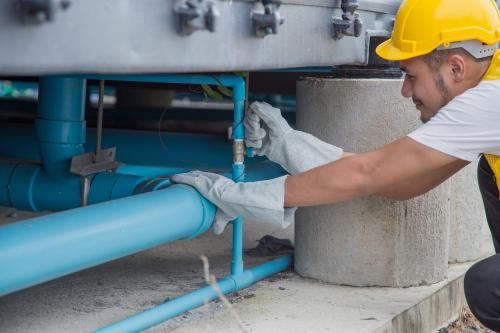A new year, a new Congress, and a new administration in the White House have raised hopes around a familiar issue: infrastructure. For decades, federal lawmakers across both parties have called for greater investment in our transportation, water, energy, telecommunications, and similar systems; now, Capitol Hill leaders, President Joe Biden, and his cabinet picks—from Transportation Secretary Pete Buttigieg to Labor Secretary Marty Walsh—are echoing calls for action. After all, it’s no secret that infrastructure spending has the potential to stimulate economic growth during recessions, including the current one.
But Washington too often frames infrastructure bills around short-term economic returns, especially when it comes to jobs. By doing so, it overlooks the generational nature of these investments and other long-term economic returns which benefit more people and places. It’s the long-term infrastructure careers that matter and should be the centerpiece of any jobs-focused infrastructure legislation.
Policymakers frequently lead their arguments with construction jobs; for instance, additional infrastructure spending can have a “multiplier effect,” with every $1 billion in federal highway investment estimated to support 13,000 jobs in a year. While construction jobs help some workers in the short term, policymakers may ignore the full range of operational jobs, which represent three-quarters of all infrastructure jobs nationally. Moving people, shipping goods, pumping water, distributing energy, and fixing broadband—these are the types of long-term, essential activities our infrastructure enables, which have become more visible during the COVID-19 pandemic. Any federal infrastructure action should look toward empowering this workforce by hiring, training, and retaining more workers as part of an infrastructure talent pipeline.
Strengthening this pipeline begins with acknowledging the variety and extent of infrastructure career pathways nationally, as past Brookings research has explored. In 2019, before the pandemic hit, 17.2 million workers—or more than one of every 10 workers nationally—were employed in infrastructure, primarily concentrated in 91 different occupations. The largest positions include truck drivers, electricians, plumbers, and other skilled trades. But many workers are also involved in administrative, financial, and managerial roles at warehouses, utilities, and engineering firms.

In other words, this pipeline is not about filling one type of job in one place, but rather, having multiple entry points and pathways available for more people in more places. This flexibility matters because a diverse range of unemployed and low-wage workers in hospitality, retail, and other industries nationally need to transition to better jobs, which will require many branching pathways.
But it’s not just the variety of positions that matters; it’s the pay and accessibility too. Infrastructure jobs not only offer higher wages, but they also pose lower formal educational barriers to entry. Policymakers need to expand the reach of these careers. From aircraft mechanics to water treatment operators, infrastructure jobs can pay 30% more to workers at lower ends of the wage spectrum. Hourly wages at the 10th and 25th percentiles stand at $13.68 and $16.82 in these jobs, compared to $10.35 and $13.02 in all jobs nationally. At the same time, around a half (53.4%) of infrastructure workers have a high school diploma or less, compared to around a third (31.7%) of all workers nationally.

While many infrastructure jobs are in the public sector and have higher unionization rates—partially explaining this wage premium—these workers also possess valuable, transferable skills and experience. Whether employed as technicians, operators, or engineers, they frequently possess higher levels of STEM knowledge and digital skills gained by on-the-job training. Strengthening an infrastructure talent pipeline, in turn, means current and prospective workers can earn and learn on the job, with access to flexible training opportunities over time rather than applying for a single position on a single project.
New infrastructure bills will have an opportunity to train people for the infrastructure jobs of today and tomorrow. Some infrastructure occupations are projected to grow rapidly over the next decade, including clean energy jobs such as wind turbine service technicians (a 60.7% increase in jobs) and solar photovoltaic installers (a 50.5% increase), compared to a 3.7% average increase for all jobs nationally. But infrastructure jobs are also projected to have high replacement needs, with 10.4% of infrastructure workers (around 1.5 million people) projected to permanently leave their jobs each year on average, particularly due to a wave of retirements.

Infrastructure legislation can also advance careers for women and people of color—a stated focus of the new administration and Congress. An aging, predominantly white and male infrastructure workforce reveals our long-standing gaps connecting younger, more diverse workers to careers in the space. In some infrastructure occupations, such as bus drivers and transportation inspectors, up to 72.7% of workers are over the age of 45. In occupations such as highway maintenance workers and power plant operators, up to 82.2% of workers are white. But the underrepresentation of women—81.9% of all infrastructure workers are male across all infrastructure jobs—is perhaps the most consistent, glaring gap.

The upside is unequivocal. Infrastructure jobs offer multiple career pathways, pay higher wages, pose lower formal educational barriers to entry, promote in-demand skills, and have demonstrated hiring needs. However, connecting workers to all these opportunities will require new policies.
Federal leaders will need to collaborate with a wide range of state, local, and private partners—including educational institutions, workforce development boards, labor groups, and employers—to expand recruitment efforts, extend work-based learning, and measure and monitor outcomes. Apprenticeships, pre-apprenticeships, internships, and other bridge programs are vital conduits to getting more workers involved in these careers. But even these programs—boosted by additional funding, for instance—will not automatically help all our disconnected, underrepresented younger and midcareer workers; ongoing supportive services, including child care and transportation, are important, as are ongoing educational and training resources, including competency-based models.
Fortunately, many national and regional efforts are already emerging to strengthen our infrastructure talent pipeline—and should build momentum for any federal plans over the coming months and years. Sector strategies, including those in water and energy, are coordinating action among employers, educators, and other groups to better target recruitment and training. Innovative regional collaborations and workforce pilots—around diversity and inclusion, in particular—are also providing guidance and case studies for broader national replication. And calls for expanding national service opportunities—including our recommendations around an “InfraCorps” program—can ideally build technical and financial capacity for new and existing federal programs.
As federal policymakers continue to raise visibility around infrastructure investment and all the jobs it can create in an economic recovery, they cannot forget the longer-term opportunities it can deliver as well.







Commentary
Biden needs to create an infrastructure talent pipeline, not just more jobs
January 29, 2021